Adding butterfly flowers and host plants is the best way to attract these stunning creatures to your yard.
You’re sure to find tons of great options that will keep them coming back for more with this list of the best butterfly plants.

The right plants and flowers will attract multiple generations of butterflies, and fill your yard with their timeless beauty year after year.
But you have to choose wisely, because there are certain types they like better than others. This list of my top picks for the best butterfly plants and flower includes both annuals and perennials.
I chose them because they’re either nectar rich for the adults, or are hosts for their larvae (the caterpillars).
To help you easily find the best options for your garden and climate, I provided basic care requirements and the hardiness zones for each one.
If you want to create a butterfly-friendly garden in your yard, you can’t go wrong with this list of the best plants.
What Are The Best Plants For Butterflies?
What types of plants do butterflies even like? There are specific attributes that attract them the most. Here are some things to look for.
Nectar Rich
Flowers rich in nectar are a primary food source for butterflies. When you have a garden full of their favorite types of food, they will stay longer, and keep coming back for more.
Host Plants
Many butterflies have plants that they prefer, or where the adults will lay their eggs. The foliage provides food for the caterpillars after they hatch, and continues to feed them as they mature.
Assorted Bright Colors
Bright colors; such as red, yellow, orange, and purple attract them more than flowers with muted tones. So be sure to include a nice assorted mix of the bright hues that they love.
Good Landing Pads
Butterflies are also more likely to spend time on flowers if they have flat tops, so they can easily perch on them while they feed. These provide a safe place where they can land, rest, and bask in the sun too.
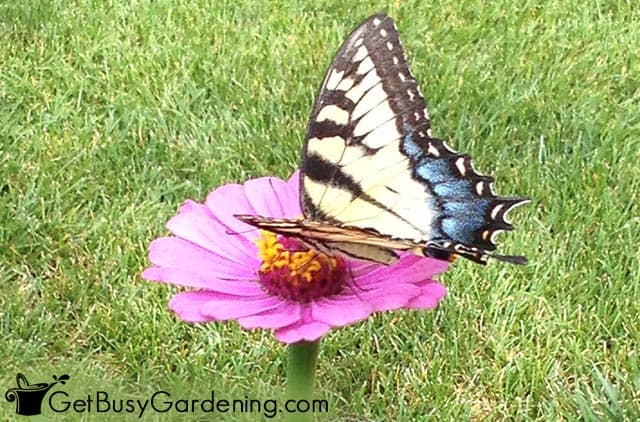
Best Butterfly Plants & Flowers List
This list contains the flowers and plants that are sure to attract, and possibly even provide a permanent home for butterflies.
1. Sunflower
These bold, yellow flowers got their name because they turn to face the sun. If it’s cloudy, they will face each other.
As their name implies, these cheery annuals need full sun. That means at least 6-8 hours of direct exposure. If you give them enough light, they can get as big as 5-10’.
Butterflies love sunflowers because they have blooms that can reach 1-3’ wide, which is plenty large enough for them to land on.
2. Salvia
These popular plants get to be about 1-3’ tall and wide, depending on the species. Butterflies flock to them because of their bright flowers in late spring to early fall.
There are tons of different types to choose from. They all thrive in full sun, and the hardiness ranges from zones 4-10.
Some varieties with light-colored blossoms will do pretty well in part-shade, but the blooms may be smaller.
3. Echinacea (Cone Flower)
With bright pink petals, echinacea is part of the daisy family. Also known as “butterfly kisses,” this hardy specimen can survive in almost any climate, but does best in zones 3 through 9.
The bold flowers can get up to 18”. They prefer full sun or light shade, so put them in the front or around the edges of your garden where they can soak plenty of rays.
Even though the plants themselves can survive the harsh winters, they bloom the best from July-September.
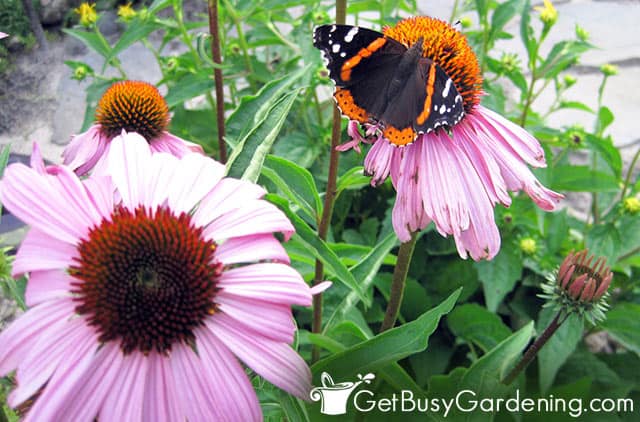
4. Penstemon
Also commonly called “beardtongues”, the penstemon family of plants have vibrant pink, electric blue, or purple flowers that attract all kinds of butterflies.
Like a few other choices on this list, they prefer full sun or light shade. They perform well in zones 3-9, and bloom from April to June.
You’ll find a wide variety to choose from, both in color and size. Depending on the species, they can be as short as 6” or as tall as 8’.
5. Lavender
Known for its calming effects on people, lavender attracts butterflies with its fragrant purple flowers. This popular herb reaches up to 24” and, depending on the type, can be hardy anywhere from zones 4-10.
It usually blooms in summer, often as early as May, but typically in June and July. This summer-loving beauty requires full sun, with at least 8 hours of direct exposure. Learn how to care for lavender here.
6. Zinnia
Another excellent plant, zinnias attract butterflies because of the extremely colorful blossoms and abundance of nectar.
From bold orange and red flowers, to the show-stopping yellow, or even white ones, they’ll add tons of color to beds or containers.
There are a few options you can choose from: dwarf varieties are only about 12”, but other types can get up to 4’ tall.
These annuals will bloom from late spring until the first hard frost of fall in any full-sun garden. Learn how to grow zinnias here.

7. Butterfly Bush (Buddleia)
Also called a summer lilac, butterflies adore this bush that is named for them because the flowers are full of nectar.
These beautiful shrubs reach heights of 6-10’ in zones 5-9. So, keep the size in mind when you plant them, they require plenty of room.
They bloom from summer to autumn, especially if they are kept in a place with direct sunlight.
8. Butterfly Weed
Another favorite nectar source, this gorgeous plant serves as food for monarch larvae too.
They have bright orange blooms from summer to early fall, and need lots of sunshine to reach their full potential of 2-3’.
Butterfly weed is native in zones 4-9, and their vivid color will liven up any garden space you put them in. Learn all about how to grow butterfly weed in your garden here.
9. Milkweed
A common native species, milkweed is one of the only things monarch caterpillars eat. So if you want to attract butterflies to your garden, these host plants are a must.
The flowers are muted, with deeper red and pink tones, and get up to 5‘ high. They require full sunlight, and will bloom from June to August in zones 4-9.
Another fantastic thing about them is that they’re perennials in many climates, so you might only need to plant them once.
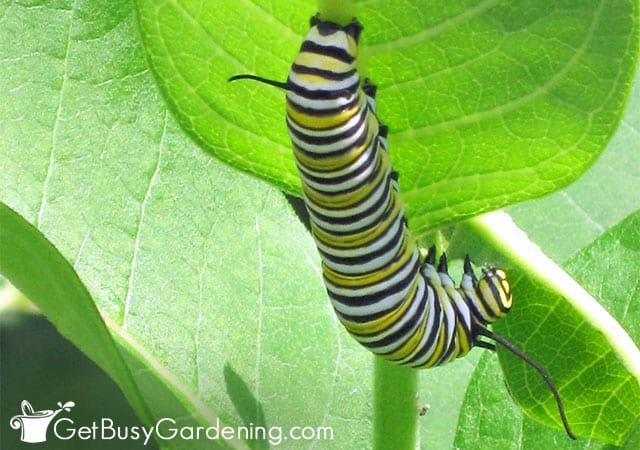
10. Joe-Pye Weed
A pretty wildflower that has bright blossoms, Joe-pye weed is a native species that can get up to 8’ in height.
These plants produce large purple flowers with a nectar that the butterflies enjoy, and they are native to many climates.
They do best in full sun, but can also thrive in partial shade. These zone 4-9 perennials bloom in late summer.
11. Liatris (Blazing Star)
Also known as blazing stars, liatris is part of the sunflower family, and native to North America.
They’re easy to spot because they can get up to 4’ in height, and have bright purple or white flowers on tall, stick-like stems.
These zone 3-8 hardy summer-blooming perennials require full sun in order to perform their best.
12. Mint
This versatile herb is best known for its aromatic and flavorful leaves. But it also blooms in June-September, and the flowers are extremely attractive to butterflies.
The blossoms are fairly small with a light purple or white shade. Mint plants stay small too, usually only 6-12”, and prefer full sun, but will tolerate partial shade.
There are tons of different varieties, and the hardiness ranges from zones 4+. They are aggressive spreaders, and for this reason many people will only use them in container gardening.
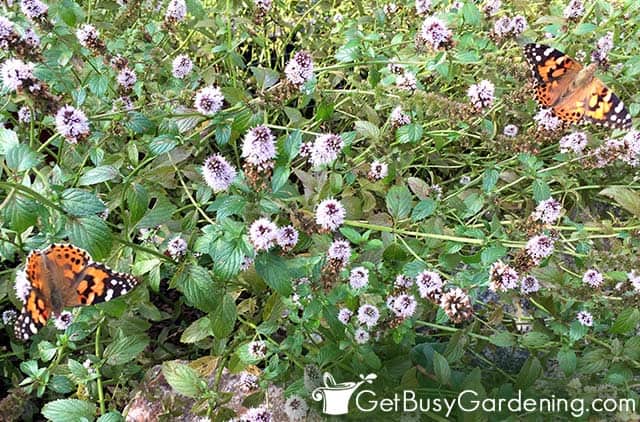
13. Goldenrod
The stunning native goldenrod can reach up to 30” tall. This is one of the best butterfly plants because the brilliant yellow blossoms provide plenty of nectar for them.
A common wildflower in zones 3-9, it blooms in either the fall or the summer. It does need full sunlight, so keep them out of the shade.
14. Cosmos
A popular annual flower that can thrive in a wide range of climates, cosmos plants attract butterflies because they have lots of rich nectar.
They do the best in full sun, and bloom from summer to early fall. Depending on the variety, they can be anywhere from 24-48” in height.
They also come in a bunch of different hues, like coral, red, orange, white, magenta, and even chocolate.
15. Bee Balm (Monarda)
Don’t let the common name fool you, monarda attracts butterflies too. Also called wild bergamot, this delicate wildflower has vibrant red or purple blooms.
They also have a very unique shape that looks like they forgot to brush their hair. When given full sun, they can get up to 4’ tall. This perennial herb flowers during the summer in zones 4-9.
Many types of beneficial pollinators favor bee balm. This makes them a very popular choice for backyard gardens.
Related Post: 21 Of The Best Plants & Flowers For Attracting Bees
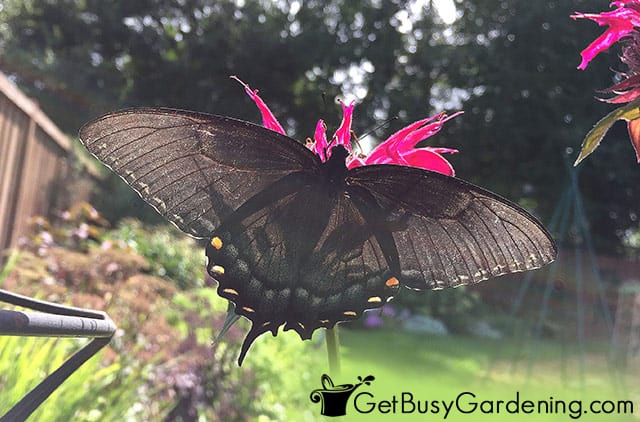
16. Aster
As one of the best plants for butterflies, asters are hosts to some species, and the caterpillars can feed on their foliage.
It’s also a fantastic choice for beginning gardeners because they are drought-resistant and very low maintenance.
Perennials in zones 3-8, they come in various heights, from as short as 12” to as tall as 4’. They require full sun, and the happy purple flowers appear in late summer through autumn.
17. Lupine
Butterflies are attracted to lupines because the flowers produce plenty of yummy nectar.
They have large and showy tall spikes that often grow 1-3’ high. They come in every color imaginable, but the most common are shades of blue and purple.
This summer bloomer does best with full sun in zones 4-8, but will tolerate partial shade. Though they are biennials, if you allow them to naturally self sow, you’ll have flowers every year.
18. Sedums
Butterflies are attracted to the abundant nectar in sedum flowers. When you’re trying to decide which types to get, pick the ones with the brightest blossoms.
There are hundreds of species available. The hardiness can be anywhere from zones 3 and up, depending on the specific type.
The tallest varieties reach up to 3’. They require full sun, and bloom the best anytime from early summer to late fall.

19. Carrot Family (Dill, Parsley, Etc)
Add food for both you and the butterflies with some umbellifers. They have umbrella-like blossoms, and include the celery, carrot, and parsley families.
Many of these are host plants for various caterpillars, and also produce lots of nectar and pollen for the adults to eat.
Most are annuals, and can have white or yellow flowers. How tall they get depends on the individual species.
Generally speaking, most varieties in this group need full sun and bloom from July-September.
Butterfly plants and flowers will add beauty to your landscape in more ways than one. Mix and match as many of these annuls and perennials as you can, and you’re sure to have a garden full of butterflies for years to come.
Recommended Reading
- Raising Butterflies in the Garden
- The Life Cycles of Butterflies (From Egg to Maturity)
- Birds, Bees, and Butterflies: Bringing Nature Into Your Yard
- Pollinator Friendly Gardening
More Flower Gardening Articles
- 19 Long Blooming Perennials For A More Beautiful Flower Garden
- 21 Of The Best Yellow Flowers (Annuals & Perennials)
- 17 Colorful & Gorgeous Shade Garden Plants
- 15 Shrubs For Partial Shade In Your Garden
- 21 Best Foundation Plants For The Front Of Your House
What butterfly plants and flowers would you add to this list? Share your favorites in the comments below.
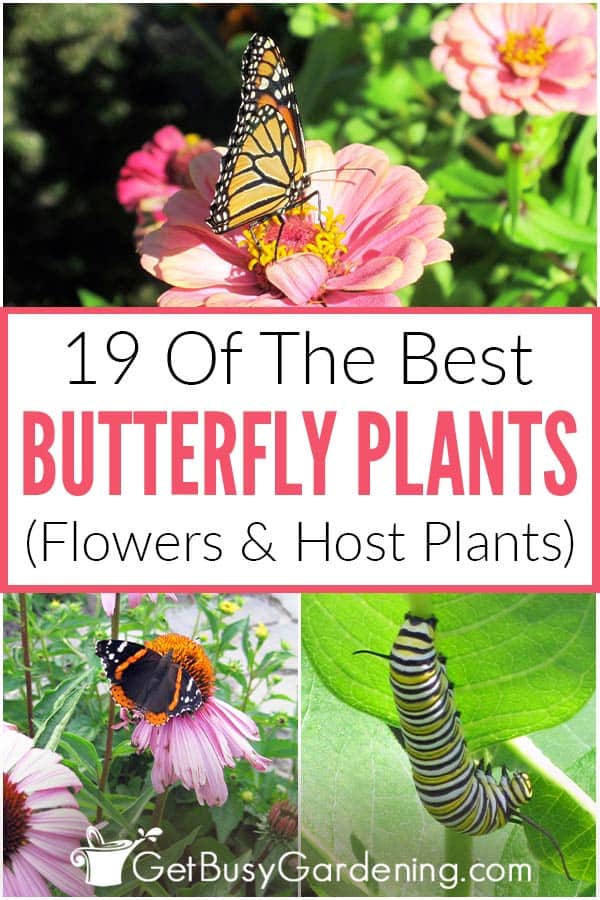
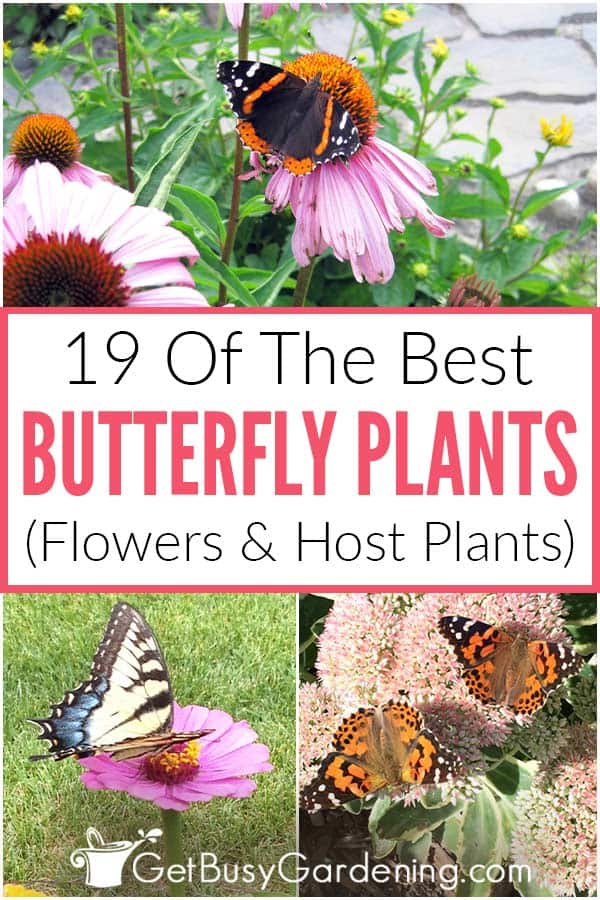
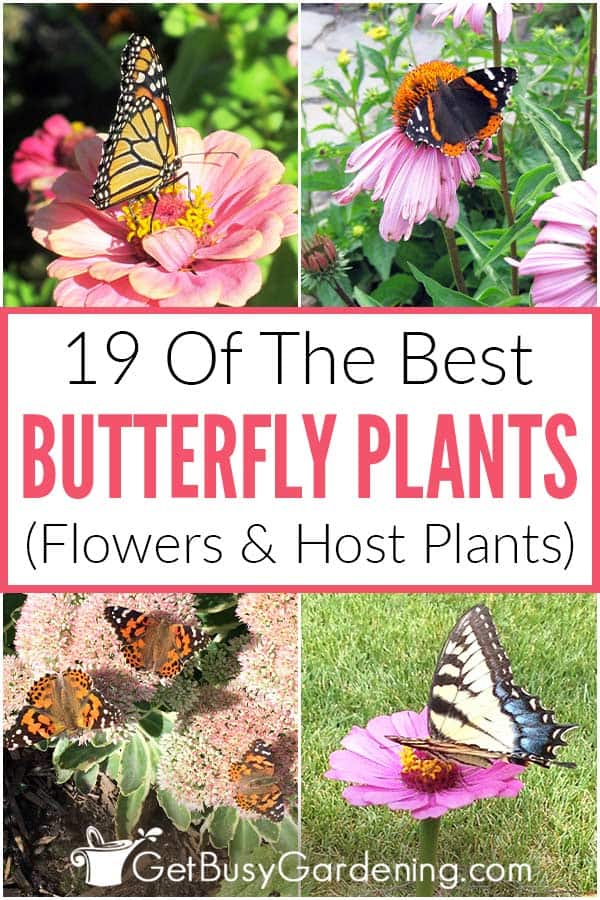


B. Eileen Adair says
Wow! I’m 71 and I feel like a two year old!
I have I younger Sister you would be Great Friends with!
My Gardening experience started with her when she came to help me when me 4th baby was born. She was sitting on her hand on our couch, I asked her what was wrong & she said”that plant really needs to be pinched back! Fast forward to 22 years ago, I became very ill and was stopped in my tracks so to speak! So I have been trying to make up for all that time!
I started my “Butterfly Garden” by asking people if I could “pinch back” their blooms. By collecting seeds I have gathered flowers from Jackson Hole,WY to New York.
I am happy to know that I have lucked out have in my garden now or in my collection of seeds that I’ve been getting almost all the plants you mentioned. One that I have a hard time with is Lavender because I’m very allergic to it!
How can I get a water source?
I have a little bird bath that I keep water in, but I live in a “drought” State and some years we can only water our gardens or yard 2 times a week. My Gardens ate all in almost full sun or very little shade.
I will hope this gets to you.
Thank you so much for all the knowledge you shared.
“Old Lady Butterfly Baby”
Amy Andrychowicz says
That’s amazing that you started your butterfly garden from seeds that you collected all around the county! Wow! The nice thing is most of the plants that attract butterflies are native and don’t need as much water as other types of flowers. Watering them once or twice a week is plenty. Just be sure to water them deeply at the base, so it can soak into the roots (never spray it over the top of the plants, that’s just a waste of water). That should be all they need to thrive!
Yvonne says
I’ve had alot of luck with Rue for the Eastern Black Swallowtail and The Dutchman’s Pipevine for the Pipevine Swallowtail.
Amy Andrychowicz says
Awesome, thanks so much for adding your favorite flowers for attracting butterflies to your garden. 🙂
J Baker says
French marigolds are good for butterflies, too